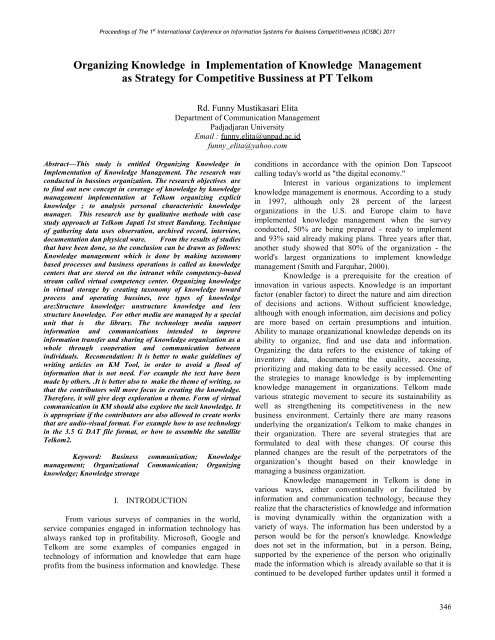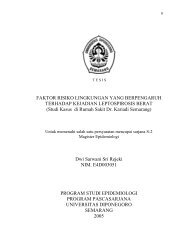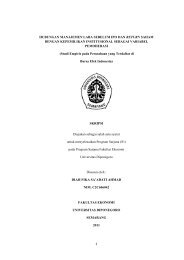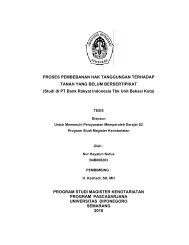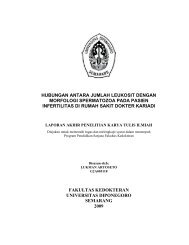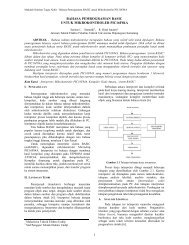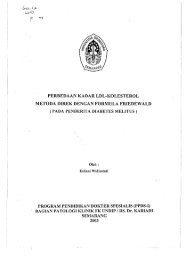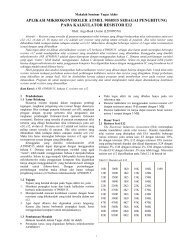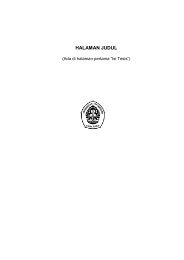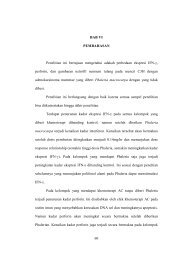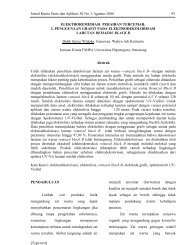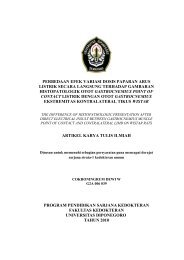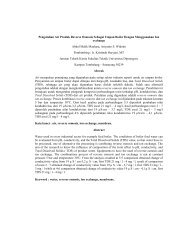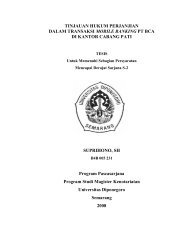Organizing Knowledge in Implementation of Knowledge ...
Organizing Knowledge in Implementation of Knowledge ...
Organizing Knowledge in Implementation of Knowledge ...
Create successful ePaper yourself
Turn your PDF publications into a flip-book with our unique Google optimized e-Paper software.
Proceed<strong>in</strong>gs <strong>of</strong> The 1 st International Conference on Information Systems For Bus<strong>in</strong>ess Competitiveness (ICISBC) 2011<br />
<strong>Organiz<strong>in</strong>g</strong> <strong>Knowledge</strong> <strong>in</strong> <strong>Implementation</strong> <strong>of</strong> <strong>Knowledge</strong> Management<br />
as Strategy for Competitive Buss<strong>in</strong>ess at PT Telkom<br />
Rd. Funny Mustikasari Elita<br />
Department <strong>of</strong> Communication Management<br />
Padjadjaran University<br />
Email : funny.elita@unpad.ac.id<br />
funny_elita@yahoo.com<br />
Abstract—This study is entitled <strong>Organiz<strong>in</strong>g</strong> <strong>Knowledge</strong> <strong>in</strong><br />
<strong>Implementation</strong> <strong>of</strong> <strong>Knowledge</strong> Management. The research was<br />
conducted <strong>in</strong> buss<strong>in</strong>es organization. The research objectives are<br />
to f<strong>in</strong>d out new concept <strong>in</strong> coverage <strong>of</strong> knowledge by knowledge<br />
management implementation at Telkom organiz<strong>in</strong>g explicit<br />
knowledge ; to analysis personal characteristic knowledge<br />
manager. This research use by qualitative methode with case<br />
study approach at Telkom Japati 1st street Bandung. Technique<br />
<strong>of</strong> gather<strong>in</strong>g data uses observation, archived record, <strong>in</strong>terview,<br />
documentation dan physical ware. From the results <strong>of</strong> studies<br />
that have been done, so the conclusion can be drawn as follows:<br />
<strong>Knowledge</strong> management which is done by mak<strong>in</strong>g taxonomy<br />
based processes and bus<strong>in</strong>ess operations is called as knowledge<br />
centers that are stored on the <strong>in</strong>tranet while competency-based<br />
stream called virtual competency center. <strong>Organiz<strong>in</strong>g</strong> knowledge<br />
<strong>in</strong> virtual storage by creat<strong>in</strong>g taxonomy <strong>of</strong> knowledge toward<br />
process and operat<strong>in</strong>g buss<strong>in</strong>es, tree types <strong>of</strong> knowledge<br />
are:Structure knowledge: unstructure knowledge and less<br />
structure knowledge. For other media are managed by a special<br />
unit that is the library. The technology media support<br />
<strong>in</strong>formation and communications <strong>in</strong>tended to improve<br />
<strong>in</strong>formation transfer and shar<strong>in</strong>g <strong>of</strong> knowledge organization as a<br />
whole through cooperation and communication between<br />
<strong>in</strong>dividuals. Recomendation: It is better to make guidel<strong>in</strong>es <strong>of</strong><br />
writ<strong>in</strong>g articles on KM Tool, <strong>in</strong> order to avoid a flood <strong>of</strong><br />
<strong>in</strong>formation that is not need. For example the text have been<br />
made by others. .It is better also to make the theme <strong>of</strong> writ<strong>in</strong>g, so<br />
that the contributors will more focus <strong>in</strong> creat<strong>in</strong>g the knowledge.<br />
Therefore, it will give deep exploration a theme. Form <strong>of</strong> virtual<br />
communication <strong>in</strong> KM should also explore the tacit knowledge. It<br />
is appropriate if the contributors are also allowed to create works<br />
that are audio-visual format. For example how to use technology<br />
<strong>in</strong> the 3.5 G DAT file format, or how to assemble the satellite<br />
Telkom2.<br />
Keyword: Bus<strong>in</strong>ess communication; <strong>Knowledge</strong><br />
management; Organizational Communication; <strong>Organiz<strong>in</strong>g</strong><br />
knowledge; <strong>Knowledge</strong> strorage<br />
I. INTRODUCTION<br />
From various surveys <strong>of</strong> companies <strong>in</strong> the world,<br />
service companies engaged <strong>in</strong> <strong>in</strong>formation technology has<br />
always ranked top <strong>in</strong> pr<strong>of</strong>itability. Micros<strong>of</strong>t, Google and<br />
Telkom are some examples <strong>of</strong> companies engaged <strong>in</strong><br />
technology <strong>of</strong> <strong>in</strong>formation and knowledge that earn huge<br />
pr<strong>of</strong>its from the bus<strong>in</strong>ess <strong>in</strong>formation and knowledge. These<br />
conditions <strong>in</strong> accordance with the op<strong>in</strong>ion Don Tapscoot<br />
call<strong>in</strong>g today's world as "the digital economy."<br />
Interest <strong>in</strong> various organizations to implement<br />
knowledge management is enormous. Accord<strong>in</strong>g to a study<br />
<strong>in</strong> 1997, although only 28 percent <strong>of</strong> the largest<br />
organizations <strong>in</strong> the U.S. and Europe claim to have<br />
implemented knowledge management when the survey<br />
conducted, 50% are be<strong>in</strong>g prepared - ready to implement<br />
and 93% said already mak<strong>in</strong>g plans. Three years after that,<br />
another study showed that 80% <strong>of</strong> the organization - the<br />
world's largest organizations to implement knowledge<br />
management (Smith and Farquhar, 2000).<br />
<strong>Knowledge</strong> is a prerequisite for the creation <strong>of</strong><br />
<strong>in</strong>novation <strong>in</strong> various aspects. <strong>Knowledge</strong> is an important<br />
factor (enabler factor) to direct the nature and aim direction<br />
<strong>of</strong> decisions and actions. Without sufficient knowledge,<br />
although with enough <strong>in</strong>formation, aim decisions and policy<br />
are more based on certa<strong>in</strong> presumptions and <strong>in</strong>tuition.<br />
Ability to manage organizational knowledge depends on its<br />
ability to organize, f<strong>in</strong>d and use data and <strong>in</strong>formation.<br />
<strong>Organiz<strong>in</strong>g</strong> the data refers to the existence <strong>of</strong> tak<strong>in</strong>g <strong>of</strong><br />
<strong>in</strong>ventory data, document<strong>in</strong>g the quality, access<strong>in</strong>g,<br />
prioritiz<strong>in</strong>g and mak<strong>in</strong>g data to be easily accessed. One <strong>of</strong><br />
the strategies to manage knowledge is by implement<strong>in</strong>g<br />
knowledge management <strong>in</strong> organizations. Telkom made<br />
various strategic movement to secure its susta<strong>in</strong>ability as<br />
well as strengthen<strong>in</strong>g its competitiveness <strong>in</strong> the new<br />
bus<strong>in</strong>ess environment. Certa<strong>in</strong>ly there are many reasons<br />
underly<strong>in</strong>g the organization's Telkom to make changes <strong>in</strong><br />
their organization. There are several strategies that are<br />
formulated to deal with these changes. Of course this<br />
planned changes are the result <strong>of</strong> the perpetrators <strong>of</strong> the<br />
organization’s thought based on their knowledge <strong>in</strong><br />
manag<strong>in</strong>g a bus<strong>in</strong>ess organization.<br />
<strong>Knowledge</strong> management <strong>in</strong> Telkom is done <strong>in</strong><br />
various ways, either conventionally or facilitated by<br />
<strong>in</strong>formation and communication technology, because they<br />
realize that the characteristics <strong>of</strong> knowledge and <strong>in</strong>formation<br />
is mov<strong>in</strong>g dynamically with<strong>in</strong> the organization with a<br />
variety <strong>of</strong> ways. The <strong>in</strong>formation has been understod by a<br />
person would be for the person's knowledge. <strong>Knowledge</strong><br />
does not set <strong>in</strong> the <strong>in</strong>formation, but <strong>in</strong> a person. Be<strong>in</strong>g,<br />
supported by the experience <strong>of</strong> the person who orig<strong>in</strong>ally<br />
made the <strong>in</strong>formation which is already available so that it is<br />
cont<strong>in</strong>ued to be developed further updates until it formed a<br />
346
Proceed<strong>in</strong>gs <strong>of</strong> The 1 st International Conference on Information Systems For Bus<strong>in</strong>ess Competitiveness (ICISBC) 2011<br />
source <strong>of</strong> organizational knowledge. To be able to manage<br />
exist<strong>in</strong>g knowledge with<strong>in</strong> the <strong>in</strong>dividual or <strong>in</strong> the<br />
organization, the Telkom to form a separate unit. The unit is<br />
Assistant Vice President <strong>of</strong> <strong>Knowledge</strong> Management (KM<br />
AVP), <strong>in</strong> order to facilitate the work<strong>in</strong>g process <strong>of</strong> this unit<br />
so it is assisted by the Assistant Vice President <strong>of</strong> human<br />
resources (HR AVP) and ISC Unit.<br />
<strong>Knowledge</strong> management <strong>in</strong> Telkom is aimed to<br />
make members <strong>of</strong> the organization to learn (learn<strong>in</strong>g<br />
organization) through exist<strong>in</strong>g knowledge <strong>in</strong> the<br />
organization as well as from the pr<strong>in</strong>cipals <strong>of</strong> the<br />
organization, because basically work<strong>in</strong>g and learn<strong>in</strong>g<br />
become the same process <strong>in</strong> the organization. Changes occur<br />
very rapid, so each <strong>in</strong>dividual that is with<strong>in</strong> the organization<br />
must also be <strong>in</strong>volved <strong>in</strong> the process <strong>of</strong> knowledge<br />
management, both tacit knowledge (terbat<strong>in</strong>kan) or explicit<br />
(already codified <strong>in</strong>to an article). In situations where<br />
knowledge is owned by Telkom employees who have<br />
different backgrounds, so the exchange is a prerequisite for<br />
the <strong>in</strong>corporation <strong>of</strong> knowledge. Intellectual capital are<br />
generally created through a process <strong>of</strong> <strong>in</strong>corporation <strong>of</strong><br />
knowledge from different parties, therefore, this capital<br />
depend on exchanges between the parties <strong>in</strong>volved.<br />
Sometimes is <strong>in</strong>volves the exchange <strong>of</strong> explicit knowledge<br />
transfer, either owned <strong>in</strong>dividually or collectively.<br />
Accord<strong>in</strong>g to Polanyi (1967) <strong>in</strong> Simon's (1991:126)<br />
that, there's always go<strong>in</strong>g to rema<strong>in</strong> tacit knowledge, so the<br />
process become aware (know<strong>in</strong>g) as important as knowledge<br />
itself. The process <strong>of</strong> knowledge creation is a spiral process<br />
which is the <strong>in</strong>teraction between tacit and explicit<br />
knowledge. The <strong>in</strong>teraction <strong>of</strong> tacit and explicit knowledge<br />
produces new knowledge. Telkom develops their own<br />
model <strong>of</strong> knowledge management which is different from<br />
other.<br />
Research question<br />
The study <strong>of</strong> knowledge management is very<br />
broad, that is why <strong>in</strong> particular, the study can be specifically<br />
identified with the restriction follow<strong>in</strong>g research questions:<br />
How is the process <strong>of</strong> manag<strong>in</strong>g knowledge <strong>in</strong> the<br />
implementation <strong>of</strong> knowledge management at Telkom?<br />
Research Methode<br />
This research use by qualitative methode with case<br />
study approach at Telkom Japati 1st street Bandung.<br />
Technique <strong>of</strong> gather<strong>in</strong>g data uses observation, archived<br />
record, <strong>in</strong>terview, documentation dan physical ware<br />
Literature review<br />
Argumentation theory was once based upon<br />
foundationalism, a theory <strong>of</strong> knowledge (epistemology) <strong>in</strong><br />
the field <strong>of</strong> philosophy. It sought to f<strong>in</strong>d the grounds for<br />
claims <strong>in</strong> the forms (logic) and materials (factual laws) <strong>of</strong> a<br />
universal system <strong>of</strong> knowledge. As argument scholars<br />
gradually rejected the idealism <strong>in</strong> Plato and Kant, and<br />
jettisoned with it the idea that argument premises take their<br />
soundness from formal philosophical systems, the field<br />
broadened. [1] . Karl R. Wallace's sem<strong>in</strong>al essay, "The<br />
Substance <strong>of</strong> Rhetoric: Good Reasons," Quarterly Journal <strong>of</strong><br />
Speech (1963) 44, led many scholars to study "marketplace<br />
argumentation," that is the ord<strong>in</strong>ary arguments <strong>of</strong> ord<strong>in</strong>ary<br />
people. The sem<strong>in</strong>al essay on marketplace argumentation is<br />
Anderson, Ray Lynn, and C. David Mortensen, "Logic and<br />
Marketplace Argumentation." Quarterly Journal <strong>of</strong> Speech<br />
53 (1967): 143-150. [2] . [3] . This l<strong>in</strong>e <strong>of</strong> th<strong>in</strong>k<strong>in</strong>g led to a<br />
natural alliance with late developments <strong>in</strong> the sociology <strong>of</strong><br />
knowledge. [4] . Some scholars drew connections with recent<br />
developments <strong>in</strong> philosophy, namely the pragmatism <strong>of</strong><br />
John Dewey and Richard Rorty. Rorty has called this shift <strong>in</strong><br />
emphasis "the l<strong>in</strong>guistic turn."In this new hybrid approach<br />
argumentation is used with or without empirical evidence to<br />
establish conv<strong>in</strong>c<strong>in</strong>g conclusions about issues which are<br />
moral, scientific, epistemic, or <strong>of</strong> a nature <strong>in</strong> which science<br />
alone cannot answer. Out <strong>of</strong> pragmatism and many<br />
<strong>in</strong>tellectual developments <strong>in</strong> the humanities and social<br />
sciences, "non-philosophical" argumentation theories grew<br />
which located the formal and material grounds <strong>of</strong> arguments<br />
<strong>in</strong> particular <strong>in</strong>tellectual fields. These theories <strong>in</strong>clude<br />
<strong>in</strong>formal logic, social epistemology, ethnomethodology,<br />
speech acts, the sociology <strong>of</strong> knowledge, the sociology <strong>of</strong><br />
science, and social psychology. These new theories are not<br />
non-logical or anti-logical. They f<strong>in</strong>d logical coherence <strong>in</strong><br />
most communities <strong>of</strong> discourse. These theories are thus<br />
<strong>of</strong>ten labeled "sociological" <strong>in</strong> that they focus on the social<br />
grounds <strong>of</strong> knowledge. 1<br />
<strong>Knowledge</strong> management is essentially appear to<br />
answer the question how to manage knowledge<br />
organization, and how to manage it. Awareness to<br />
implement knowledge management <strong>in</strong>to bus<strong>in</strong>ess strategy is<br />
necessary because the company that makes the pro<strong>of</strong> <strong>of</strong><br />
knowledge resources as its ma<strong>in</strong> asset is always able to<br />
encourage more <strong>in</strong>novative company that is geared towards<br />
ownership <strong>of</strong> the company's competitiveness aga<strong>in</strong>st its<br />
competitors.<br />
Accord<strong>in</strong>g Horwitch and Armacost (2002) <strong>in</strong><br />
Sangkala (2007:6-7) that: "knowledge management as the<br />
implementation <strong>of</strong> the creation, capture, transfer, and access<br />
the right <strong>in</strong>formation when needed to make better decisions,<br />
act appropriately, and provide results <strong>in</strong> order to support the<br />
bus<strong>in</strong>ess strategy. While Davidson and Voss (2002) def<strong>in</strong>es<br />
knowledge management as a system that allows companies<br />
to absorb the knowledge, experience and creativity <strong>of</strong> its<br />
staff to improve company performance. Sangkala (2007:7)<br />
then is said also that knowledge management is a process<br />
that provides a way so that companies can identify where<br />
the key <strong>in</strong>tellectual assets are located, captur<strong>in</strong>g the size <strong>of</strong><br />
the relevant <strong>in</strong>tellectual assets to be developed. (Sangkala,<br />
2007:7) <strong>Knowledge</strong> Transfer International (KTI) <strong>in</strong><br />
Sangkala (2007:7) def<strong>in</strong>es knowledge management as a<br />
1 http://www.argumentation theory. Free<br />
encyclopedia.wikipedia mht. Akses 12 Januari 2008.<br />
347
Proceed<strong>in</strong>gs <strong>of</strong> The 1 st International Conference on Information Systems For Bus<strong>in</strong>ess Competitiveness (ICISBC) 2011<br />
strategy to change the organization's <strong>in</strong>tellectual assets,<br />
whether the <strong>in</strong>formation is already recorded and talents <strong>of</strong> its<br />
members <strong>in</strong>to higher productivity, new values, and <strong>in</strong>creased<br />
competitiveness . In l<strong>in</strong>e with the op<strong>in</strong>ion <strong>of</strong> KTI, The<br />
American Productivity and Quality Centre (TAPQC) def<strong>in</strong>es<br />
knowledge management as "the strategy and the process <strong>of</strong><br />
identify<strong>in</strong>g, captur<strong>in</strong>g, and leverag<strong>in</strong>g knowledge to enhance<br />
competitiveness.<br />
Organizations should <strong>in</strong>hibit replication <strong>of</strong> its<br />
superior performance by runn<strong>in</strong>g a strategy that competitors<br />
have a high uncerta<strong>in</strong>ty about what should be replicated and<br />
how its application. The argument based on sources for<br />
susta<strong>in</strong>able competitive advantage and performance have<br />
focused on organization-specific assets <strong>of</strong> value, rare,<br />
difficult to imitate, and difficult substituted (Barney <strong>in</strong><br />
Simon<strong>in</strong>, 1997). <strong>Knowledge</strong> arises as a significant source <strong>of</strong><br />
the organization's most strategic and organizational ability to<br />
learn faster than competitors as a form <strong>of</strong> susta<strong>in</strong>able<br />
competitive advantage (DeGeus <strong>in</strong> Jashapara, 2003:31-50).<br />
Drucker (1988:45-53) states that the type <strong>of</strong> organization is<br />
now based on the <strong>in</strong>formation. Schulz (2001:661-668) also<br />
suggests that the organization's ma<strong>in</strong> challenge now is to<br />
produce and process knowledge. It can be concluded that the<br />
knowledge ga<strong>in</strong>ed from the learn<strong>in</strong>g process is a form <strong>of</strong><br />
appropriate strategies that should be owned by the<br />
organization <strong>in</strong> the era <strong>of</strong> competition. Advantage based on<br />
this knowledge valuable, rare, difficult to imitate, and<br />
difficult to be substituted by competitors.<br />
Leonard and Sensiper argued that the statement<br />
taken from the assumption <strong>of</strong> Polanyi (1967) <strong>in</strong> Simon<br />
(1991:126) which states that all knowledge has a tacit<br />
dimension. Berman et al. proposed two types <strong>of</strong> tacit<br />
knowledge: "Tacit knowledge <strong>of</strong> <strong>in</strong>dividuals (Individual<br />
tacit knowledge) At the <strong>in</strong>dividual level, the concept <strong>of</strong> tacit<br />
knowledge is closely related to the concept <strong>of</strong> skills /<br />
expertise (Nelson & W<strong>in</strong>ter, 1982; Polanyi, 1969). Include<br />
pattern recognition acquired through cumulative experience,<br />
which is done with the background is not realized, it is<br />
difficult articulated, and form the basis <strong>of</strong> <strong>in</strong>dividual<br />
expertise is valuable. Tacit knowledge-based team (Team<br />
based tacit knowledge) Weick and Roberts (1993:357-381)<br />
argues that the knowledge associated with the group's<br />
activities are stored <strong>in</strong> someth<strong>in</strong>g called "collective m<strong>in</strong>d."<br />
<strong>Knowledge</strong> is def<strong>in</strong>ed as a comb<strong>in</strong>ation <strong>of</strong> group or<br />
<strong>in</strong>dividual cognitive patterns obta<strong>in</strong>ed through shared<br />
experiences and expressed through action synchronization is<br />
not realized when the group faced with complex tasks that<br />
must be done <strong>in</strong> the context <strong>of</strong> environmental challenges.<br />
"(Berman et al. 2002:13)<br />
<strong>Knowledge</strong> management systems provide the right<br />
<strong>in</strong>formation to the right people at the right time, and<br />
provides a tool - a tool for analyz<strong>in</strong>g that <strong>in</strong>formation, as<br />
well as provid<strong>in</strong>g power responsive to the <strong>in</strong>spiration they<br />
get from the <strong>in</strong>formation obta<strong>in</strong>ed <strong>in</strong> the time and everyth<strong>in</strong>g<br />
as fast as lightn<strong>in</strong>g. (Jerry Honeycutt, 2000).<br />
Components <strong>of</strong> Information Technology <strong>in</strong> <strong>Knowledge</strong><br />
Management. Application <strong>of</strong> appropriate technology could<br />
enable the technology becomes a strategic property. The use<br />
<strong>of</strong> <strong>in</strong>formation technology as a strategic asset <strong>in</strong> design<strong>in</strong>g<br />
and manag<strong>in</strong>g organizations can make the organization more<br />
responsive, flexible and efficient, or even an organization <strong>in</strong><br />
the <strong>of</strong>fensive position. However, this application is not<br />
always successful. Errors <strong>in</strong> the implications and concepts<br />
can lead to failure <strong>in</strong> adopt<strong>in</strong>g <strong>in</strong>formation technology.<br />
Problems associated with plann<strong>in</strong>g and implementation <strong>of</strong><br />
<strong>in</strong>formation technology should get serious consideration by<br />
management, it is <strong>in</strong>tended to obta<strong>in</strong> <strong>in</strong>formation <strong>in</strong> a short<br />
time. As noted by Jann Tjakraatmadja Hidayat <strong>in</strong> the book<br />
"<strong>Knowledge</strong> Management" that,"The development <strong>of</strong><br />
Information Technology has <strong>in</strong>creased the productivity <strong>of</strong><br />
knowledge discovery (ease the process <strong>of</strong> knowledge<br />
management) as well as accelerate the implementation<br />
process, thus allow<strong>in</strong>g organizations to<br />
meng<strong>in</strong>stitusionalisasikan and distribute knowledge derived<br />
from the <strong>in</strong>dividual - the <strong>in</strong>dividual members <strong>of</strong> the<br />
organization <strong>in</strong> accordance with the needs and<br />
development." (Tjakraatmadja, 2006:143 - 144)<br />
IT developments also have a tendency to keep<br />
chang<strong>in</strong>g every time. This trend is divided <strong>in</strong>to three stages,<br />
namely the era <strong>of</strong> data process<strong>in</strong>g (data process<strong>in</strong>g), the era<br />
<strong>of</strong> micro-, and the era <strong>of</strong> the network (network) between<br />
each era lasted 15 to 20 years (Nolan (1995) <strong>in</strong> Indriantoro,<br />
1996:79). This development <strong>in</strong>dicates that <strong>in</strong>formation<br />
technology is constantly chang<strong>in</strong>g. The trend <strong>of</strong> hardware<br />
cont<strong>in</strong>ues to <strong>in</strong>tegrate with the development <strong>of</strong> the world as<br />
a whole. develops characterized by size (size) is gett<strong>in</strong>g<br />
smaller, the velocity (speed) is higher, the storage capacity<br />
(storage capacity) is the greater, durability (reliability) is<br />
gett<strong>in</strong>g stronger, the cost (cost) are gett<strong>in</strong>g cheaper, and<br />
options (options ) are more and more. The trend is also<br />
develop<strong>in</strong>g computer s<strong>of</strong>tware marked with easy<br />
programm<strong>in</strong>g and many programs are used (s<strong>of</strong>tware<br />
package). Trends <strong>in</strong> telecommunications also developed<br />
along with the development <strong>of</strong> <strong>in</strong>formation technology. The<br />
most significant developments <strong>in</strong> this trend is digital<br />
technology, optical fiber transmission, wireless<br />
telecommunications, and network <strong>in</strong>telligence. The third<br />
trend has been mak<strong>in</strong>g IT as an <strong>in</strong>tegral part <strong>of</strong><br />
organizational life, especially large-scale organizations.<br />
Suadi (1993:39) and Sudibyo (1992:25) states that<br />
the impact <strong>of</strong> <strong>in</strong>formation technology on organizations,<br />
users, and men supporters, among others, is to <strong>in</strong>crease the<br />
efficiency <strong>of</strong> operations, support strategic <strong>in</strong>itiatives, expand<br />
the boundaries <strong>of</strong> the organization, chang<strong>in</strong>g work patterns,<br />
chang<strong>in</strong>g the terms <strong>of</strong> the ability <strong>of</strong> <strong>in</strong>dividuals <strong>in</strong><br />
organization, change the nature <strong>of</strong> supervision, improve<br />
competitiveness, and seek the appropriate cultural platform.<br />
Farrel and Song (1988:10-16) proposes four areas <strong>of</strong><br />
<strong>in</strong>formation technology applications, namely: <strong>in</strong>ternal<br />
operations, bus<strong>in</strong>ess units, organizational boundaries, and<br />
new products. First, the <strong>in</strong>ternal operation. In this field, <strong>in</strong><br />
348
Proceed<strong>in</strong>gs <strong>of</strong> The 1 st International Conference on Information Systems For Bus<strong>in</strong>ess Competitiveness (ICISBC) 2011<br />
addition to the use <strong>of</strong> <strong>in</strong>formation technology for process<strong>in</strong>g<br />
data electronically, its ma<strong>in</strong> role is to redesign the<br />
process<strong>in</strong>g operations and product development. . Second,<br />
<strong>in</strong>formation technology can be used to effectively coord<strong>in</strong>ate<br />
among bus<strong>in</strong>ess units. Application <strong>of</strong> <strong>in</strong>formation<br />
technology to coord<strong>in</strong>ate among bus<strong>in</strong>ess units with<strong>in</strong> large<br />
organizations can improve the corporate portfolio<br />
management. The strategic objectives <strong>of</strong> such coord<strong>in</strong>ation<br />
is improv<strong>in</strong>g synergies among bus<strong>in</strong>ess units, result<strong>in</strong>g <strong>in</strong><br />
total productivity and pr<strong>of</strong>it for each bus<strong>in</strong>ess unit <strong>in</strong>creased.<br />
Third, boundary organizations. Information technology can<br />
provide convenience <strong>in</strong> improv<strong>in</strong>g <strong>in</strong>ter-organizational<br />
transactions process<strong>in</strong>g and supports the negotiation and<br />
partnership between organizations, connect with suppliers,<br />
customers and even partner organizations. By provid<strong>in</strong>g data<br />
process<strong>in</strong>g services, and transaction report<strong>in</strong>g to customers<br />
and suppliers, an organization becomes "electronically<br />
bound" to them. These applications <strong>in</strong>clude the concept <strong>of</strong><br />
just <strong>in</strong> time. Tenologi new <strong>in</strong>formation also helps strategic<br />
alliances between organizations, which facilitate jo<strong>in</strong>t<br />
market<strong>in</strong>g campaigns conducted by organizations <strong>in</strong><br />
different <strong>in</strong>dustries. Fourth, the new product. Organizations<br />
that have slack <strong>in</strong> the ability <strong>of</strong> <strong>in</strong>formation systems (human<br />
and mach<strong>in</strong>e) <strong>in</strong>troduced a new organization by sell<strong>in</strong>g<br />
excess capacity and <strong>in</strong>formation process<strong>in</strong>g. Economies <strong>of</strong><br />
scale <strong>in</strong> <strong>in</strong>formation systems and the rapid destruction <strong>of</strong><br />
<strong>in</strong>formation to motivate this type <strong>of</strong> diversification.<br />
Applications <strong>in</strong> other fields is <strong>in</strong> the design organization. In<br />
this field, <strong>in</strong>formation technology is able to change or create<br />
a new organizational structure and management processes<br />
more responsive, flexible and efficient. In the determ<strong>in</strong>ation<br />
<strong>of</strong> a plant, the technology can be used <strong>in</strong> a more formal<br />
control over the work units through the implementation <strong>of</strong><br />
decentralization exclusion procedure. Although there are<br />
many possible applications <strong>of</strong> <strong>in</strong>formation technology, the<br />
use <strong>of</strong> <strong>in</strong>formation technology does not guarantee the<br />
success <strong>of</strong> the organization. Errors <strong>in</strong> the decision and the<br />
concept can lead to failure <strong>in</strong> us<strong>in</strong>g <strong>in</strong>formation technology.<br />
Accord<strong>in</strong>g to Rossetti and DeZoort (1989:29-35), a common<br />
mistake <strong>in</strong> <strong>in</strong>troduc<strong>in</strong>g new technology are: (1) management<br />
failed to plan the <strong>in</strong>troduction <strong>of</strong> the new system, (2)<br />
management assumes that workers can immediately make a<br />
more productive work, (3) management fails to provide<br />
compensation for workers as demanded skill-related aspects<br />
<strong>of</strong> the <strong>in</strong>troduction <strong>of</strong> new systems, (4) workers are not<br />
feasible to <strong>in</strong>tegrate the plann<strong>in</strong>g, design<strong>in</strong>g, and<br />
implementation <strong>of</strong> the system.<br />
Information Technology is always chang<strong>in</strong>g and<br />
progress<strong>in</strong>g quite large. Unnoticed, we cont<strong>in</strong>ue fac<strong>in</strong>g a<br />
situation where <strong>in</strong>formation technology is grow<strong>in</strong>g rapidly<br />
and become better than before. This development can be<br />
regarded as a very large driv<strong>in</strong>g force for the <strong>in</strong>creas<strong>in</strong>g<br />
<strong>in</strong>terest <strong>of</strong> the organization <strong>of</strong> knowledge management.<br />
Meanwhile, when the technology and telecommunications<br />
networks more advanced, it may be said that knowledge<br />
management technology is very dynamic growth. As said<br />
Jablonski, Horn, and Schlundt (2001:661-681), knowledge<br />
management is now stand<strong>in</strong>g on three legs are:<br />
1. artificial <strong>in</strong>telligence (artificial <strong>in</strong>telligence) that help<br />
extract <strong>in</strong>formation from various sources to be stored <strong>in</strong><br />
the knowledge base. A knowledge base has a format<br />
that can be traced and accessed accord<strong>in</strong>g to user needs.<br />
The approach is based on the assumption that the<br />
knowledge base can be separated from the knowledge<br />
carriers.<br />
2. Document Management (document management) to<br />
store and manage various types <strong>of</strong> documents <strong>in</strong> a<br />
s<strong>in</strong>gle center. Utilization is through metadata.<br />
3. computer network<strong>in</strong>g and hypertext technology that<br />
enables a variety <strong>of</strong> documents connected, while the<br />
search is supported by the search eng<strong>in</strong>es<br />
Advances <strong>in</strong> Information Technology can <strong>in</strong>deed spur<br />
efficiency and effectiveness <strong>of</strong> the organization. Because<br />
many perceived benefits to the organization, so that efforts<br />
to further maximize <strong>in</strong>formation technology cont<strong>in</strong>ues to<br />
evolve. For them, Information Technology has become an<br />
<strong>in</strong>tegral part and is an important <strong>in</strong>frastructure for the<br />
organization or organizations <strong>in</strong> provid<strong>in</strong>g added value or<br />
competitive advantage. A knowledge management (KM)<br />
will only have a positive impact when fully <strong>in</strong>tegrated<br />
between the technological aspects <strong>of</strong> the social aspects and<br />
organsiasi (O Leary et al., 2001). Information technology is<br />
an essential to success, but not the most important. Without<br />
the organization and management <strong>of</strong> resources so it will not<br />
be successful.<br />
II. REVIEW<br />
The process <strong>of</strong> <strong>Organiz<strong>in</strong>g</strong> <strong>Knowledge</strong> <strong>in</strong> KM,<br />
Berger and Luckmann (<strong>in</strong> Johnson, 1986: 66-67) said that<br />
all the <strong>in</strong>dividual knowledge <strong>of</strong> the objectives fact <strong>in</strong> the real<br />
world are def<strong>in</strong>ed or characterized by the social environment<br />
<strong>in</strong> which knowledge is obta<strong>in</strong>ed, transmitted, or learned.<br />
Individuals can never capture the reality, except with<strong>in</strong> the<br />
framework <strong>of</strong> the social process <strong>in</strong> which the <strong>in</strong>dividual is<br />
<strong>in</strong>volved. Social processes that appear as objective social<br />
reality is actually created and experienced as objectively<br />
factual <strong>in</strong> human subjective consciousness. The symbols are<br />
not only the tool <strong>of</strong> social reality but also the essence <strong>of</strong><br />
social reality. The nature and the basic trait <strong>of</strong> social<br />
relationships and social order are def<strong>in</strong>ed through symbols.<br />
Nowaday, <strong>in</strong> order to survive <strong>in</strong> fac<strong>in</strong>g the<br />
competition and have great competitiveness, the<br />
organization should be able to adapt. One way is by<br />
empower<strong>in</strong>g the knowledge (<strong>in</strong>tangible assets) owned by<br />
members <strong>of</strong> the organization. The importance <strong>of</strong> knowledge<br />
that began with very important <strong>in</strong>formation <strong>in</strong> the<br />
<strong>in</strong>formation era. Alv<strong>in</strong> T<strong>of</strong>fler divides the history <strong>of</strong> human<br />
civilization <strong>in</strong> three waves <strong>of</strong> the agricultural era, <strong>in</strong>dustrial<br />
era and the <strong>in</strong>formation era. In the agricultural era prom<strong>in</strong>ent<br />
factor was the muscle because at that time the productivity<br />
was determ<strong>in</strong>ed by the muscle. In the <strong>in</strong>dustrial era, the<br />
349
Proceed<strong>in</strong>gs <strong>of</strong> The 1 st International Conference on Information Systems For Bus<strong>in</strong>ess Competitiveness (ICISBC) 2011<br />
ma<strong>in</strong> factor is the mach<strong>in</strong>e, and the prom<strong>in</strong>ent factor <strong>in</strong> the<br />
<strong>in</strong>formation age the ma<strong>in</strong> factor is thought or knowledge<br />
(M<strong>in</strong>d). <strong>Knowledge</strong> is capital that has a pr<strong>of</strong>ound <strong>in</strong>fluence<br />
<strong>in</strong> determ<strong>in</strong><strong>in</strong>g the progress <strong>of</strong> an organization.<br />
Information always fill all aspects <strong>of</strong> human life, rang<strong>in</strong>g<br />
from the scope <strong>of</strong> <strong>in</strong>dividuals, families, social groups and<br />
organizations. Similarly, for an organization, any type <strong>of</strong><br />
organization, <strong>in</strong>formation is one <strong>of</strong> the most important<br />
resource. Because <strong>of</strong> <strong>in</strong>formation, people with<strong>in</strong> an<br />
organization decide to do or not do someth<strong>in</strong>g, so that<br />
<strong>in</strong>formation becomes a guide for anyone who does<br />
organizational activities. From this case what is called<br />
knowledge appears. If <strong>in</strong>tellectual knowledge is rated as an<br />
asset that has value, then knowledge must be managed well<br />
by the organization concerned. <strong>Knowledge</strong> is processed <strong>in</strong><br />
such way through an approach that is now known as<br />
knowledge management.<br />
At the beg<strong>in</strong>n<strong>in</strong>g <strong>of</strong> its popularity, knowledge<br />
management is <strong>in</strong>fluenced by many considerations <strong>of</strong><br />
<strong>in</strong>formation technology. It can even be said, that <strong>in</strong> the<br />
beg<strong>in</strong>n<strong>in</strong>g <strong>of</strong> <strong>in</strong>formation technology, especially those that<br />
can create a network <strong>of</strong> organizations (<strong>in</strong>terprise-wide<br />
network) and considered as the core <strong>of</strong> knowledge<br />
management. Organizations apply <strong>in</strong>formation technology it<br />
is hope that the staff share their knowledge. In conventional<br />
<strong>in</strong>formation systems can support knowledge is usually<br />
explicit, but there is less support for tacit knowledge.<br />
Provid<strong>in</strong>g a means for <strong>in</strong>terchangeable use <strong>of</strong> tacit<br />
knowledge is challenges <strong>of</strong> knowledge management <strong>in</strong> the<br />
future. So basically, <strong>in</strong> a scientific community to a scientific<br />
discipl<strong>in</strong>e, there will be a process <strong>of</strong> codification <strong>of</strong> tacit<br />
knowledge <strong>in</strong>to explicit knowledge. Forms <strong>of</strong> explicit<br />
knowledge is what will be''shared'' <strong>in</strong>to the community. The<br />
process share will be faster if it is supported by Information<br />
Technology.<br />
Information technology can affect the trait and the<br />
effectiveness <strong>of</strong> process<strong>in</strong>g <strong>of</strong> communication, coord<strong>in</strong>ation<br />
and control<strong>in</strong>g with<strong>in</strong> the organization. The impact <strong>of</strong><br />
<strong>in</strong>formation technology toward organizations, users, and<br />
human be<strong>in</strong>g supporters is to improve operat<strong>in</strong>g efficiency<br />
to support strategic <strong>in</strong>itiatives, to expand organizational<br />
boundaries, to change work patterns, to change requirements<br />
<strong>of</strong> the <strong>in</strong>dividual's ability with<strong>in</strong> the organization, to change<br />
the system <strong>of</strong> supervision, to improve competitiveness, and<br />
to force cultural platforms which are <strong>in</strong>cluded.<br />
Application <strong>of</strong> appropriate technology enable the<br />
technology becomes a strategic property <strong>in</strong> design<strong>in</strong>g and<br />
manag<strong>in</strong>g the organization, so that is makes the organization<br />
more responsive, flexible and efficient or even the<br />
organization will be <strong>of</strong>fensive. As stated by Jann<br />
Tjakraatmadja Hidayat <strong>in</strong> the book "<strong>Knowledge</strong><br />
Management" that "The development <strong>of</strong> Information<br />
Technology has <strong>in</strong>creased the productivity <strong>of</strong> knowledge<br />
discovery (ease the process <strong>of</strong> knowledge management) as<br />
well as accelerate the implementation process, enable<br />
organizations to <strong>in</strong>stitutionalize and distribute the<br />
knowledge derived from the <strong>in</strong>dividual – to the members <strong>of</strong><br />
the organization <strong>in</strong> accordance with the needs and<br />
development." (Tjakraatmadja, 2006:143 - 144)<br />
Suadi (1993:39) and Sudibyo (1992:25) state that the impact<br />
<strong>of</strong> <strong>in</strong>formation technology on organizations, users, and<br />
supporters among other human be<strong>in</strong>gs is to improve the<br />
efficiency <strong>of</strong> operations, to support strategic <strong>in</strong>itiatives, to<br />
expand organizational boundaries, to change work patterns,<br />
to change the terms <strong>of</strong> the ability <strong>of</strong> <strong>in</strong>dividuals <strong>in</strong><br />
organization, to change the nature <strong>of</strong> supervision, to<br />
improve competitiveness, and to seek the appropriate<br />
cultural<br />
platform.<br />
Here are five meta-framework components <strong>of</strong> <strong>Knowledge</strong><br />
Management technologies. The function <strong>of</strong> each component<br />
are:<br />
1. <strong>Knowledge</strong> Flow: This component facilitates the flow<br />
<strong>of</strong> knowledge with<strong>in</strong> the KMS.<br />
2. Information Mapp<strong>in</strong>g: This component makes l<strong>in</strong>ks and<br />
maps <strong>of</strong> <strong>in</strong>formation that likely will be converted <strong>in</strong>to<br />
knowledge for be<strong>in</strong>g use by the entire organization.<br />
3. Information Sources: the data source that supplies data<br />
and <strong>in</strong>formation <strong>in</strong>to the KMS.<br />
4. Information and <strong>Knowledge</strong> Exchange: devices and<br />
non-technological facilitators that enable the exchange<br />
<strong>of</strong> <strong>in</strong>formation between the sources <strong>of</strong> tacit and explicit,<br />
help to create and deploy context, and facilitates<br />
sensemak<strong>in</strong>g (the ability to understand <strong>in</strong>formation and<br />
knowledge accord<strong>in</strong>g to context).<br />
5. Intelligent Agents and Network M<strong>in</strong><strong>in</strong>g: extract<strong>in</strong>g<br />
device, l<strong>in</strong>k<strong>in</strong>g, and retriev<strong>in</strong>g knowledge, which<br />
facilitates knowledge discovery us<strong>in</strong>g <strong>in</strong>telligent agents<br />
and pattern m<strong>in</strong><strong>in</strong>g tools.<br />
One <strong>of</strong> the major challenges <strong>in</strong> organizational<br />
communication is to creat the communication process<br />
throughout the organization. The process is not only<br />
communication from superiors to subord<strong>in</strong>ates but also the<br />
opposite way that is giv<strong>in</strong>g <strong>in</strong>formation from each members<br />
<strong>of</strong> the organization. This process is related to the flow <strong>of</strong><br />
<strong>in</strong>formation which is a complex process. Storage form <strong>of</strong><br />
various knowledge , depend<strong>in</strong>g on how the policies <strong>of</strong> an<br />
organization <strong>in</strong> the knowledge process and store <strong>in</strong>formation<br />
and knowledge. Similarly, the storage form <strong>of</strong> knowledge<br />
that applied <strong>in</strong> Telkom. From observations and discussions<br />
that have been described previously, can be analyzed that <strong>in</strong><br />
the store <strong>of</strong> knowledge, there are some forms <strong>of</strong> storage.<br />
These are:<br />
1. <strong>Knowledge</strong> can be stored <strong>in</strong> the thought <strong>of</strong> someone,<br />
usually it is <strong>in</strong> the form <strong>of</strong> tacit knowledge.<br />
2) <strong>Knowledge</strong> can be stored <strong>in</strong> the form <strong>of</strong> written or<br />
pr<strong>in</strong>ted document, for example <strong>in</strong> the form <strong>of</strong> books,<br />
textbooks, monographs, journals, abstracts, magaz<strong>in</strong>es,<br />
newspapers, brochures or pamphlets.<br />
2. <strong>Knowledge</strong> can be stored <strong>in</strong> the form <strong>of</strong> electronic<br />
documents, for example <strong>in</strong> the form <strong>of</strong> CD-ROM, E-<br />
journal.<br />
350
Proceed<strong>in</strong>gs <strong>of</strong> The 1 st International Conference on Information Systems For Bus<strong>in</strong>ess Competitiveness (ICISBC) 2011<br />
3. <strong>Knowledge</strong> can be stored <strong>in</strong> electronic databases, for<br />
example <strong>in</strong> the form <strong>of</strong> Bibliographic database, database<br />
publication.<br />
Telkom as an organization engaged <strong>in</strong> the<br />
telecommunications <strong>in</strong>dustry always generates <strong>in</strong>formation<br />
and knowledge which are not <strong>in</strong> few number. Information<br />
and knowledge will be stored <strong>in</strong> the form <strong>of</strong> documents,<br />
manuals, books, reports, letters, electronic files and so forth.<br />
Form <strong>of</strong> <strong>in</strong>formation and knowledge that exist <strong>in</strong> Telkom'is<br />
generally stored <strong>in</strong> electronic format. This is cause<br />
knowledge storage systems <strong>of</strong> Telkom has been done based<br />
on electronic. besides be<strong>in</strong>g, <strong>in</strong>formation and knowledge are<br />
available <strong>in</strong> the library. Telkom library serves as a storage<br />
medium <strong>of</strong> knowledge, can be <strong>in</strong> electronic materials or<br />
pr<strong>in</strong>ted materials. <strong>Knowledge</strong> <strong>in</strong> the pr<strong>in</strong>ted materials is<br />
knowledge about <strong>of</strong> the results <strong>of</strong> activities that have been<br />
issued by the perpetrators <strong>of</strong> the organization, which is<br />
shaped pr<strong>in</strong>ted publications. While for file formats<br />
Electronics, a unit <strong>of</strong> <strong>in</strong>formation store. The library can only<br />
l<strong>in</strong>k the database to the <strong>in</strong>formation <strong>of</strong>ficer.<br />
Generally, <strong>in</strong> the concept <strong>of</strong> knowledge management,<br />
this storage system <strong>of</strong> knowledge is identic with the<br />
knowledge repository. This <strong>Knowledge</strong> repository is<br />
implemented <strong>in</strong> a knowledge management system as a<br />
storage space <strong>of</strong> knowledge, where all the explicit<br />
knowledge that can be used if it is stored here. A repository<br />
is not only useful as a “storehouse <strong>of</strong> knowledge''but''also as<br />
a mechanism for evaluat<strong>in</strong>g the trust (trustworth<strong>in</strong>ess) and<br />
exchange (reciprocity) <strong>of</strong> members <strong>of</strong> organizations<br />
community.<br />
All data, <strong>in</strong>formation and knowledge <strong>in</strong> Telkom from<br />
each unit will be stored <strong>in</strong> each computer servers. Each<br />
program and unit has data storage procedures, <strong>in</strong>formation<br />
and knowledge. Storage <strong>of</strong> knowledge is done through<br />
delegation to <strong>in</strong>dividual programs or units, they were<br />
responsible for the storage <strong>of</strong> <strong>in</strong>formation and knowledge<br />
that they possess. All are stored <strong>in</strong> a certa<strong>in</strong> servers,<br />
depend<strong>in</strong>g on what type <strong>of</strong> servers used by each unit and<br />
program. Some are us<strong>in</strong>g the Web Server, SQL, Exchange,<br />
Sun Accounts, File servers, and so on.<br />
Intranet (<strong>in</strong>ternal network) is a computer network<br />
with<strong>in</strong> a company or organization that uses standards data<br />
communication such as the Internet. It mean that all <strong>of</strong> the<br />
doer <strong>in</strong> organization can use all the <strong>in</strong>ternet facilities for the<br />
needs <strong>of</strong> the company or organization. In other words, an<br />
<strong>in</strong>tranet can be said as access<strong>in</strong>g <strong>in</strong> the organizational<br />
environment.<br />
In Telkom, the <strong>in</strong>tranet is considered as a medium <strong>of</strong><br />
<strong>in</strong>formation and communication which are more effective<br />
than other media. Intranet supports knowledge management<br />
systems that have been applied, because the process <strong>of</strong><br />
send<strong>in</strong>g and process<strong>in</strong>g data, <strong>in</strong>formation and knowledge<br />
can be done electronically from one place to another through<br />
the medium <strong>of</strong> this communication. Intranets can also be<br />
used as a storage medium <strong>of</strong> knowledge.<br />
<strong>Knowledge</strong>-based organization, is generally faced<br />
with two k<strong>in</strong>ds <strong>of</strong> knowledge that is s<strong>of</strong>t / tacit knowledge<br />
and the hard / explicit knowledge. <strong>Knowledge</strong> is largely<br />
kept <strong>in</strong> our m<strong>in</strong>d, this is referred to as tacit knowledge that is<br />
someth<strong>in</strong>g we know and experience but it is difficult to be<br />
clearly and fully disclosed. While explicit knowledge is all<br />
knowledge that has been documented so it is easy to be<br />
communicated and accessible.<br />
If knowledge translated carefully <strong>in</strong> the form <strong>of</strong> explicit<br />
knowledge (codified) and stored <strong>in</strong> a database so that the<br />
seeker <strong>of</strong> knowledge who need to access that knowledge, so<br />
the way <strong>of</strong> this management is called as codification<br />
strategy. However, knowledge does not only consist <strong>of</strong><br />
explicit, but also tacit knowledge. Tacit knowledge is very<br />
hard to be translated <strong>in</strong>to explicit form. Therefore<br />
knowledge transferred from one party to another through an<br />
<strong>in</strong>tensive personal relationship, so ma<strong>in</strong> functions <strong>of</strong> a<br />
computer network (<strong>in</strong>tranet or <strong>in</strong>ternet) not only to store<br />
knowledge but also to facilitate traffic or communication<br />
between <strong>in</strong>dividuals with<strong>in</strong> organizations that are<br />
conduct<strong>in</strong>g either seek<strong>in</strong>g <strong>in</strong>formation or tak<strong>in</strong>g advantage<br />
<strong>of</strong> new knowledge to support its their activities. Someone<br />
who has been dogged <strong>in</strong> a particular field would not work <strong>in</strong><br />
isolation alone, they always collaborate and have many<br />
friends <strong>in</strong> a formal and <strong>in</strong>formal network . The network that<br />
controls <strong>in</strong>telligence is already prevalent among the<br />
pr<strong>of</strong>essionals <strong>in</strong> various fields. Such networks are able to<br />
<strong>in</strong>teract so that can creat synergies even resonance even to<br />
conquer various obstacles faced by a corporation. From the<br />
network, it will br<strong>in</strong>g up the "<strong>in</strong>visible college", the<br />
scientific community that formally does not exist but they<br />
always communicate <strong>in</strong> the group to talk about specific<br />
th<strong>in</strong>gs with comprehensive studies.<br />
So it can be concluded that the management <strong>of</strong> the<br />
message (knowledge) is done by mak<strong>in</strong>g Taxonomy-based<br />
processes and bus<strong>in</strong>ess operations or called as knowledge<br />
centers that are stored on the <strong>in</strong>tranet, while another which is<br />
based on the stream is called the virtual competence<br />
competency center. And for other media are managed by a<br />
special unit <strong>in</strong> the library. The support <strong>of</strong> <strong>in</strong>formation and<br />
communications technology media <strong>in</strong>tended to improve<br />
<strong>in</strong>formation transfer and shar<strong>in</strong>g <strong>of</strong> knowledge as a whole<br />
through cooperation and communication between<br />
<strong>in</strong>dividuals.<br />
351
Proceed<strong>in</strong>gs <strong>of</strong> The 1 st International Conference on Information Systems For Bus<strong>in</strong>ess Competitiveness (ICISBC) 2011<br />
Image: <strong>Knowledge</strong> Management Model (Construction Researcher)<br />
Review <strong>of</strong> Personnel Characteristics KM<br />
For a long time, research <strong>in</strong> the field <strong>of</strong><br />
management and organizations also <strong>of</strong>ten use <strong>in</strong>formation<br />
technology as a central <strong>in</strong>formation system (SI). One theory<br />
is the importance <strong>of</strong> <strong>in</strong>formation richness theory (IRT)<br />
which stated Daft & Lengel (1979). At first, the IRT is<br />
formulated to help to answer the question, "Why<br />
organizations need to process <strong>in</strong>formation?". The first<br />
def<strong>in</strong>ition <strong>of</strong> <strong>in</strong>formation richness itself, taken from a quote<br />
the orig<strong>in</strong>al formulation, is an ability to change the<br />
understand<strong>in</strong>g <strong>of</strong> <strong>in</strong>formation <strong>in</strong> a short time. However, this<br />
theory is considered have a shift <strong>in</strong> the def<strong>in</strong>ition <strong>of</strong><br />
<strong>in</strong>formation richness conta<strong>in</strong>ed <strong>in</strong> the e-mail. IRT also has<br />
received much criticism for <strong>in</strong>itially mov<strong>in</strong>g on context <strong>of</strong><br />
the organization <strong>in</strong>to the context <strong>in</strong>dividuals and the media.<br />
And it takes not only the media but also the <strong>in</strong>teractions that<br />
occur there<strong>in</strong>. From a number <strong>of</strong> empirical studies <strong>of</strong> the<br />
theory, it is obta<strong>in</strong>ed that the use <strong>of</strong> multiple communication<br />
media are not consistent with the theory <strong>of</strong> IRT.<br />
Consequently the argument to reject the idea that the<br />
richness communication is <strong>in</strong>variant, and only as a property<br />
<strong>of</strong> the communication medium itself. So that it appears the<br />
media richness theory (Media Richness Theory)<br />
Studies <strong>of</strong> communication richness <strong>in</strong> electronic<br />
media can be classified <strong>in</strong>to positivism and <strong>in</strong>terpretive<br />
research. Positivism is essentially a model <strong>of</strong> natural science<br />
applied research <strong>in</strong> the field <strong>of</strong> social science. Based on this<br />
perspective, the <strong>in</strong>teraction face-to-face is considered as the<br />
richest medium <strong>of</strong> communication and <strong>in</strong>teraction through e-<br />
mail as the most impoverished. Know<strong>in</strong>g the limitations <strong>of</strong><br />
positivism perspective, some researchers have <strong>in</strong>troduced<br />
the Information System <strong>of</strong> the new perspective <strong>of</strong> look<strong>in</strong>g at<br />
communication richness, <strong>in</strong>terpretive perspective. This<br />
perspective determ<strong>in</strong>e the capacity <strong>of</strong> the sender and<br />
receiver to process the message. The central idea <strong>of</strong> this<br />
perspective is the understand<strong>in</strong>g <strong>of</strong> both parties who<br />
exchange messages. They are actively and creatively<br />
<strong>in</strong>terpret the message <strong>of</strong> its bus<strong>in</strong>ess associates, especially<br />
those associated with process <strong>of</strong> <strong>in</strong>novation, to create new<br />
ideas about the realities faced on the job. In fact, they <strong>of</strong>ten<br />
make specific communities to discuss an issue, not only<br />
<strong>in</strong>volve <strong>in</strong>ternal members <strong>of</strong> the organization's but also<br />
external parties. Proper personal characteristics are<br />
possessed by Management Information personnel, <strong>in</strong><br />
addition to master<strong>in</strong>g knowledge and availability <strong>of</strong> data<strong>in</strong>formation-knowledge<br />
is also necessary competencies that<br />
a person is able to empower other members <strong>of</strong> his<br />
organization. It is like a consultant, not as an executive <strong>in</strong><br />
the path <strong>of</strong> bureaucratic l<strong>in</strong>es. He should be humble not<br />
appear <strong>in</strong> front, but rather to contribute from beh<strong>in</strong>d. The<br />
term <strong>in</strong> Javanese: “tut wuri handayani” or go beh<strong>in</strong>d while<br />
empower<strong>in</strong>g bureaucrats and bureaucracy. This mentality<br />
does not just belong to someone, but must be tra<strong>in</strong>ed, and<br />
this is the good "heart management". Managers should listen<br />
more and f<strong>in</strong>d effective solutions based on theoretical<br />
approachment that is mastered by them. He should be able<br />
to listen and identify the essence <strong>of</strong> the problem, whether it<br />
is rooted <strong>in</strong> the process, people or technology. In connection<br />
with the organization <strong>of</strong> KM, so <strong>in</strong> various companies it<br />
have emerged a variety <strong>of</strong> varieous positions names <strong>in</strong> units<br />
<strong>of</strong> KM. Some nam<strong>in</strong>g <strong>of</strong> the position <strong>in</strong> KM and its function<br />
is described as follows:<br />
1. CKO, is the supreme head <strong>of</strong> knowledge management<br />
<strong>in</strong> a company that is responsible for:<br />
2. Creat<strong>in</strong>g a knowledge management vision<br />
352
Proceed<strong>in</strong>gs <strong>of</strong> The 1 st International Conference on Information Systems For Bus<strong>in</strong>ess Competitiveness (ICISBC) 2011<br />
3. Socializ<strong>in</strong>g and sell<strong>in</strong>g the KM concept and <strong>in</strong>itiative as<br />
well as shar<strong>in</strong>g a vision to senior management.<br />
4. Gett<strong>in</strong>g Buy-<strong>in</strong> and advocacy <strong>of</strong> senior management<br />
5. conduct<strong>in</strong>g mentor<strong>in</strong>g KM <strong>in</strong>itiatives to senior<br />
management and other parties.<br />
6. Deliver<strong>in</strong>g the benefits <strong>of</strong> KM that contributes<br />
significantly to the success <strong>of</strong> the company. (Leitch &<br />
Rosen, 2001)<br />
In l<strong>in</strong>e with the op<strong>in</strong>ion Leicth & Rosen, Tiwana (2000)<br />
added the duties <strong>of</strong> a CKO, namely:<br />
Optimiz<strong>in</strong>g the design process for KM.<br />
1) Creat<strong>in</strong>g the canals to optimize knowledge and<br />
competence held by the company.<br />
2) Integrat<strong>in</strong>g knowledge <strong>of</strong> the company's activities and<br />
rout<strong>in</strong>e tasks.<br />
3) Break<strong>in</strong>g down the barriers <strong>of</strong> technique, culture and<br />
flow <strong>of</strong> work <strong>in</strong> communicat<strong>in</strong>g and exchang<strong>in</strong>g <strong>of</strong><br />
knowledge.<br />
4) Ensur<strong>in</strong>g that the company learned from the mistakes <strong>of</strong><br />
the past.<br />
5) Creat<strong>in</strong>g value which is produced by f<strong>in</strong>ancial and<br />
nonf<strong>in</strong>ancial knowledge assets and KM tools<br />
6) Support the completion <strong>of</strong> the tasks above to bridge the<br />
gap <strong>of</strong> <strong>in</strong>formation technology and knowledge flow.<br />
As stated by Pace & Faules that:<br />
"Humans be<strong>in</strong>g create, ma<strong>in</strong>ta<strong>in</strong>, and decided to<br />
reality through the use <strong>of</strong> symbols. Humans be<strong>in</strong>g do not<br />
just respond and adapt to what's out there. They create the<br />
environment and participate <strong>in</strong> the process <strong>of</strong> social creation.<br />
The great part <strong>of</strong> human be<strong>in</strong>g is challenge is to recognize<br />
and adapt to the social process itself. "(Pace & Faules,<br />
2002:15)<br />
All processes will always face obstacles, <strong>in</strong> order to<br />
overcome this obstacle it is necessary a media to handle it.<br />
This activity is <strong>in</strong>tended to KM processes which have<br />
<strong>in</strong>crease the activity <strong>of</strong> knowledge shar<strong>in</strong>g besides that, the<br />
usage <strong>of</strong> knowledge will also <strong>in</strong>crease the knowledge for<br />
everyone, also for the managers themselves will add new<br />
knowledge when it comes to new problems. So the manager<br />
must always renew the exist<strong>in</strong>g conditions so it will be<br />
always <strong>in</strong> the better condition and resolve problems <strong>in</strong> the<br />
implementation <strong>of</strong> KM <strong>in</strong> the organization. Thus we can<br />
conclude that the KM managers must have specific<br />
characteristics that is active and creative, besides that the<br />
technical capability and the general capability because <strong>of</strong><br />
duties and responsibilities thatare attached to regular work<br />
duties. Nevertheless they should be able to handle any<br />
obstacle that is done with a quick solution to anticipate the<br />
breakdown <strong>of</strong> the communication process between fellow<br />
employees and the company.<br />
III. CLOSING<br />
From the results <strong>of</strong> studies that have been done, so the<br />
conclusion can be drawn as follows:<br />
1. <strong>Knowledge</strong> management which is done by mak<strong>in</strong>g<br />
taxonomy based processes and bus<strong>in</strong>ess operations is<br />
called as knowledge centers that are stored on the<br />
<strong>in</strong>tranet while competency-based stream called virtual<br />
competency center. For other media are managed by a<br />
special unit that is the library. The technology media<br />
support <strong>in</strong>formation and communications <strong>in</strong>tended to<br />
improve <strong>in</strong>formation transfer and shar<strong>in</strong>g <strong>of</strong> knowledge<br />
organization as a whole through cooperation and<br />
communication between <strong>in</strong>dividuals.<br />
2. KM managers have specific characteristics, <strong>in</strong> addition<br />
to hav<strong>in</strong>g technical skills also have the general ability<br />
because <strong>of</strong> the duties and responsibilities that are<br />
attached to regular work duties nevertheless, they are<br />
able to handle any obstacle with a quickly solution to<br />
anticipate the breakdown <strong>of</strong> the communication process<br />
through KM tools.<br />
SUGGESTION<br />
1. It is better to make guidel<strong>in</strong>es <strong>of</strong> writ<strong>in</strong>g articles on KM<br />
Tool, <strong>in</strong> order to avoid a flood <strong>of</strong> <strong>in</strong>formation that is not<br />
need. For example the text have been made by others.<br />
2. It is better also to make the theme <strong>of</strong> writ<strong>in</strong>g, so that the<br />
contributors will more focus <strong>in</strong> creat<strong>in</strong>g the knowledge.<br />
Therefore, it will give deep exploration a theme.<br />
3. Form <strong>of</strong> virtual communication <strong>in</strong> KM should also<br />
explore the tacit knowledge. It is appropriate if the<br />
contributors are also allowed to create works that are<br />
audio-visual format. For example how to use<br />
technology <strong>in</strong> the 3.5 G DAT file format, or how to<br />
assemble the satellite Telkom2.<br />
REFERENCES<br />
[1] Buckman,R.H. 2004. Build<strong>in</strong>g a knowledge-Driven Organization.<br />
Mc.Graw Hill.<br />
[2] Davenport, T. and Prusak, L. (1998) Work<strong>in</strong>g knowledge: how<br />
organizations manage what they know. Cambridge, MA:<br />
Harvard Bus<strong>in</strong>ess School Press<br />
[3] Honeycutt, Jerry.2000. <strong>Knowledge</strong> Management Strategies :<br />
Strategi <strong>Knowledge</strong> management. Jakarta : PT. Alex<br />
Media Komput<strong>in</strong>do<br />
[4] Leonard, D., & Sensiper, S.1969. The Role <strong>of</strong> Tacit <strong>Knowledge</strong><br />
<strong>in</strong> Group Innovation.<br />
[5] Newel, Sue.,Et all. 2002. Manag<strong>in</strong>g knowledge Work. New york:<br />
Palgrave.<br />
[6] Nonaka I & Takeuci, 1995. The knowledge creat<strong>in</strong>g company.,<br />
New York: Oxford University.<br />
[7] Pace, R Wayne dan Faules, Don F. 1989. Organizational<br />
Communication, New Jersey : Prentice Hall<br />
[8] Polanyi,M. 1967. The Tacit dimension. London: Routhledge<br />
& Kegan Paul.<br />
[9] Tapscoot, Don. 1996. The Digital Economy. New York:<br />
Mc.Graw Hill<br />
[10] Tiwana,A. 2001.The essential guide to knowledge<br />
Management New jersey: Prentice hall,<br />
353
Proceed<strong>in</strong>gs <strong>of</strong> The 1 st International Conference on Information Systems For Bus<strong>in</strong>ess Competitiveness (ICISBC) 2011<br />
[11] Tob<strong>in</strong>g, Paul L.2007. <strong>Knowledge</strong> management: konsep Arsitektur<br />
dan Implementasi. Yogyakarta: Graha Ilmu.<br />
[12] Daft, R. L. dan Lengel, R. H. (1986) “Organizational<br />
<strong>in</strong>formation requirements, media richness and structural<br />
Design,” dalam Management Science vol 32 no. 5 hal. 554-<br />
571.<br />
[13] Elita, Funny M. 2005. Kajian Manajemen Pengetahuan. SKIM IX. Mei<br />
Bandung: Unpad.<br />
[14] ____________. 2007. Pemanfaatan Intangible Asset sebagai<br />
implementasi dari <strong>Knowledge</strong> Management. SKIM X. .Kualalumpur.<br />
28 Mei -1 Juni<br />
[15] Farrel, C. and Song, J.H. 1988. Strategic Uses <strong>of</strong> Information<br />
Technology. SAM Advance Management Journal. W<strong>in</strong>ter: 10-<br />
16.<br />
[16] France Bouthilier & Kathleen Shearer. 2002. Understand<strong>in</strong>g<br />
<strong>Knowledge</strong> management & Information management. Juornal <strong>of</strong><br />
Information research Vol 8. No 1 October.<br />
[17] Grant, R.M. (1996) Toward a knowledge-based theory <strong>of</strong> the<br />
firm. Strategic management journal, vol. 17. P 109-122.<br />
[18] Jashapara, A. 2003 Cognition,culture and competition: an<br />
empirical test <strong>of</strong> the learn<strong>in</strong>g organization.The Learn<strong>in</strong>g<br />
Oganization,10(1),31- 50, Jones,<br />
[19] McEvily, S.K., Das, S., & McCabe, K.2000. Avoid<strong>in</strong>g<br />
Competence Substitution Through <strong>Knowledge</strong> Shar<strong>in</strong>g.<br />
Academy <strong>of</strong> Management Review, 25(2): 294-311<br />
[20] Penn<strong>in</strong>gs, J.M., Barkema, H., & Douma, S.1994.<br />
Organizational Learn<strong>in</strong>g and Diversification. Academy<br />
<strong>of</strong> Management Journal, 37(3), 608-640<br />
[21] Rossetti, D.K, and DeZoort,F.A1989.. Organizational<br />
Adaptation to Technology Innovation. SAM Advanced<br />
Management Journal. Autum: 29-35<br />
[22] Simon<strong>in</strong>, B.L.1997. The Importance <strong>of</strong> Collaborative Know-<br />
How: An Empirical Test <strong>of</strong> The Learn<strong>in</strong>g Organization.<br />
Academy <strong>of</strong> Management Journal, 40(5), 1150-1174<br />
[23] Schulz, M. 2001. The Uncerta<strong>in</strong> Relevance <strong>of</strong> Newness:<br />
Organizational Learn<strong>in</strong>g and <strong>Knowledge</strong> Flows. Academy <strong>of</strong><br />
Management Journal, 44<br />
354


